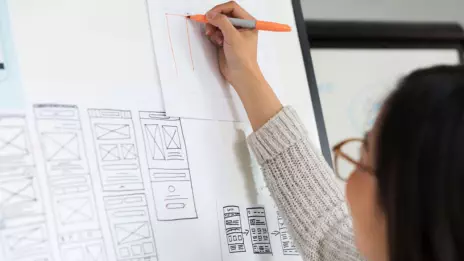
Knowing what a web designer needs to start your new website can be confusing:
Well, what if I told you that you can be 100% equipped with the knowledge and info you need for your web designer to start your site tomorrow, with just a few simple tips…
…in fact six simple tips you can implement right now:
Tips which will not only make sure you hit the ground running with any web designer you contact, but will also help you…
- Save time…
- Build a more profitable site…
- Look like an organised professional who’s great to work with…
Drawing from many years of experience working with many small businesses. Here are 6 crucial preparations for a successful small business website, that you can start right now…
Table of Contents
1. Establish the goal of your website
Ask yourself the question:
What is the single most important thing my website needs to accomplish?
Is it to:
- Increase inbound email enquires?
- Increase inbound call leads?
- Grow your email list subscribers?
- Increase online e-commerce sales?
- Or something else?
Whatever it is, you need to define it, clearly.
Yes, you may want your site to provide information and build your brand, but you need to be as specific as possible with your goal if you want to get the most from your website.
And remember, don’t blindly follow what others businesses or industries are doing. Different businesses have different needs. You’re not Facebook and your competitors aren’t always taking the correct approach. Forget what others are doing.
What do you want?
Establish the chief purpose of your website, because above all else, your website is a marketing tool, and it should be designed to achieve the specific objective most appropriate for your small business.
Notice!: Want help defining your core website goal? Pick a time on my calendar for your complementary website discovery call here.
2. Clearly define your perfect customer
The most successful businesses know how essential it is to have a clear understanding of their ideal customer.
They invest in analysing their needs, preferences and behaviours so that they’re better able to target, attract and market to them.
Your website and small business should be no different:
It should be designed around a specific individual or customer avatar, rather than a broad, generic demographic. Why? Because acquiring customers is similar to a game darts, if you aim for the bullseye you’re more likely to hit the board and score.
If you haven’t gotten around it, do it now:
Create a clear, distinct description of your perfect customer. It should be a key component of the blueprint you use it to guide every decision that you and your Web Designer make.
3. Buy your website domain name
It’s easy for people to forget a badly named small businesses or brand.
A good domain name will help you avoid that – it’s one of the most important parts of your branding strategy. Make sure it’s unique, memorable and cohesive with your business and the image you want to project.
Buying a domain name is easy, simply:
- Decide on a suitable domain name
- Check if your domain available at reputable registra such as Namecheap
- Buy your domain to register it in your name
Make sure your save the details your registra emails you so you can pass them to your website designer.
Here’s something else to make sure you do:
Once you buy a domain name, convey to your Web designer the ”why” behind your chosen domain name…
It will help them to design your new website with a clear purpose and message. It will empower them to design not just a widget, button or a header – but your unique brand.
4. Prepare your content
If you want to create the best user experience for your new website…
…and get the best results from your website and website designer:
You must take the website content first approach and prepare your launch content before hiring a website designer.
Preparing your website content upfront will make sure your web designer is able to view it’s structure, tone and style so they can understand your business, create the best information architecture and user experience for your website users and help you turn more visitors into leads and sales.
Good designers solve problems, so empower your web designer to create your website around your content, rather than the other way around, and you’ll achieve a far more effective website.
Imagine this:
Compelling copy, thoughtfully structured into a user-friendly layout and effective design; leading to a specific call-to-action that drives more leads and sales for your company.
It’s a winning combination that will capture and convert visitors into ideal customers.
5. List your online contact details
It’s surprising how many small business websites do not display contact details or a call to action clearly.
Imagine how frustrating this is for your customers and how big a loss it can be for your business if your website can’t clearly show proof that you’re a real, accessible business.
Presenting your contact details clearly is the simplest and most effective way to increase your website leads and show you’re legitimate.
It’s not always appropriate for every small business to display every contact method available. Again, it depends on your businesses specific goals. But when your visitor is interested, you must provide them (and your designer!) with a clear next step, and this usually means a clear and obvious method of contact.
So the sooner you provide your web designer with an exact email address, telephone number, social media profiles or any other contact details you need to display on your site, the sooner they can start designing the best solution to present this information clearly across your new website.
Providing your precise contact details upfront will really help your web designer to plan your website in the best way possible, as well as save time for both of you in the long run.
6. Compile your logo, images and brand assets
Most people are highly visual… we’re drawn to beautiful things:
The images you put on your website will make an instant impact and help to determine how well your message is relayed to your audience.
If you can, it pays to:
Create a killer logo design and gather it along with any other high quality images and brand assets you would like to use on your website. It will help your web designer to establish the ideal brand image for your site and get started quickly.
Most web designers should be willing to source stock images for you if want, but it’s best to provide your own unique images upfront if you can. It will help your site to look more authentic, establish your brand personality and prevent the development of your beautiful new website from stalling.
Small inputs lead to big outcomes
By communicating and setting your Web Designer up with the information and assets they need, you’ll be able to get the most out of them and your new small business website, whilst freeing yourself to focus on the core responsibilities of growing your small business.
With these preparations in place and the right Web Designer on board, you’ll find you’ll have less interruptions and more time on your hands.
You’ll be free to attend to the more profitable (or strategic/important/fun) stuff and…
…you’ll get to enjoy a better life-work balance, which is really the key to being a sharper, smarter and better business owner.
Over to you…
Do you have any tips, questions, or success (or horror) stories about hiring a Web designer or preparing to build a small business website? Let me know in the comments section below!
And lastly, if you’d like the help of my freelance web design services to build your small business website, please pick a time on my calendar for your complementary website discovery call here.


